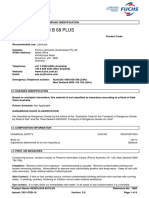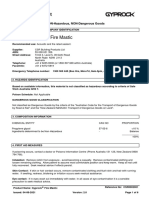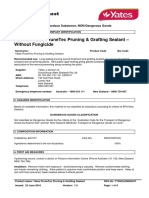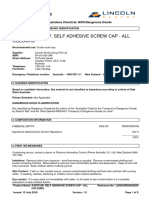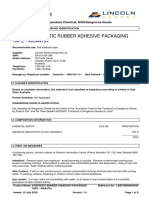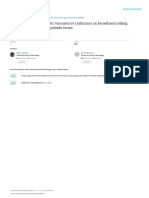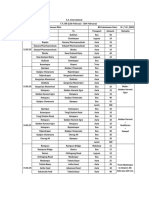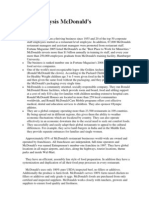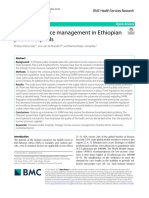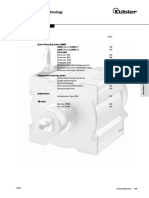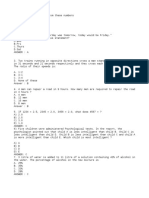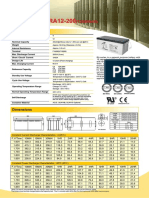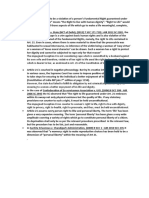Stabyl 300 Al 2-SDS
Stabyl 300 Al 2-SDS
Uploaded by
rifat hassanCopyright:
Available Formats
Stabyl 300 Al 2-SDS
Stabyl 300 Al 2-SDS
Uploaded by
rifat hassanOriginal Description:
Original Title
Copyright
Available Formats
Share this document
Did you find this document useful?
Is this content inappropriate?
Copyright:
Available Formats
Stabyl 300 Al 2-SDS
Stabyl 300 Al 2-SDS
Uploaded by
rifat hassanCopyright:
Available Formats
Safety Data Sheet
Hazardous Substance, NON-Dangerous Goods
1. MATERIAL AND SUPPLY COMPANY IDENTIFICATION
Product name: STABYL 300 AL 2
Recommended use: Grease.
Supplier: Fuchs Lubricants (Australasia) Pty Ltd Fuchs Lubricants (New Zealand) Pty Ltd
ABN: 88 005 681 916
Street Address: 49 McIntyre Road Harbourside Business Park
Sunshine VIC 3020 485C Rosebank Road
Avondale, Auckland
Australia New Zealand
Telephone: +613 9300 6400 +649 828 3255
Facsimile: +613 9300 6401 +649 830 3643
Emergency Telephone number: Australia 1800 638 556 (24hr)
New Zealand 0800 154 166 (24hr)
2. HAZARDS IDENTIFICATION
This material is hazardous according to health criteria of Safe Work Australia.
Signal Word
Warning
Hazard Classification
Serious Eye Damage/Irritation - Category 2A
Hazard Statement
H319 Causes serious eye irritation.
Prevention Precautionary Statements
P264 Wash hands, face and all exposed skin thoroughly after handling.
P280 Wear eye/face protection.
Response Precautionary Statements
P305+P351+P338 IF IN EYES: Rinse cautiously with water for several minutes. Remove contact
lenses, if present and easy to do. Continue rinsing.
P337+P313 If eye irritation persists: Get medical advice/attention.
Storage Precautionary Statement
Not allocated
Disposal Precautionary Statement
Not allocated
Poison Schedule: Not Applicable
DANGEROUS GOOD CLASSIFICATION
Product Name: STABYL 300 AL 2 Reference No: 3218
Issued: 2016-07-12 Version: 2.0 Page 1 of 6
Safety Data Sheet
Not classified as Dangerous Goods by the criteria of the "Australian Code for the Transport of Dangerous Goods
by Road & Rail" and the "New Zealand NZS5433: Transport of Dangerous Goods on Land".
3. COMPOSITION INFORMATION
CHEMICAL ENTITY CAS NO PROPORTION
Mixture of the substances listed below with harmless additions.
ZnDTP 68457-79-4 <3 %
4. FIRST AID MEASURES
If poisoning occurs, contact a doctor or Poisons Information Centre (Phone Australia 131 126, New Zealand 0800
764 766).
Inhalation: Remove victim from exposure - avoid becoming a casualty. Remove contaminated clothing and
loosen remaining clothing. Allow patient to assume most comfortable position and keep warm. Keep at rest until
fully recovered. Seek medical advice if effects persist.
Skin Contact: If skin or hair contact occurs, remove contaminated clothing and flush skin and hair with running
water. If swelling, redness, blistering or irritation occurs seek medical assistance.
Eye contact: If in eyes, hold eyelids apart and flush the eyes continuously with running water. Continue flushing
until advised to stop by the Poisons Information Centre or a Doctor; or for at least 15 minutes and transport to
Doctor or Hospital.
Ingestion: Rinse mouth with water. If swallowed, do NOT induce vomiting. Give a glass of water to drink.
Never give anything by the mouth to an unconscious patient. If vomiting occurs give further water. Seek medical
advice.
Notes to physician: Treat symptomatically.
5. FIRE FIGHTING MEASURES
Hazchem Code: Not applicable.
Suitable extinguishing media: If material is involved in a fire use water fog (or if unavailable fine water spray),
alcohol resistant foam, standard foam, dry agent (carbon dioxide, dry chemical powder).
Specific hazards: Combustible material.
Fire fighting further advice: On burning or decomposing may emit toxic fumes. Fire fighters to wear self-
contained breathing apparatus and suitable protective clothing if risk of exposure to vapour or products of
combustion or decomposition.
6. ACCIDENTAL RELEASE MEASURES
SMALL SPILLS
Wear protective equipment to prevent skin and eye contamination. Avoid inhalation of vapours or dust. Wipe up
with absorbent (clean rag or paper towels). Collect and seal in properly labelled containers or drums for disposal.
LARGE SPILLS
Clear area of all unprotected personnel. Slippery when spilt. Avoid accidents, clean up immediately. Wear
protective equipment to prevent skin and eye contamination and the inhalation of dust. Work up wind or increase
Product Name: STABYL 300 AL 2 Reference No: 3218
Issued: 2016-07-12 Version: 2.0 Page 2 of 6
Safety Data Sheet
ventilation. Cover with damp absorbent (inert material, sand or soil). Sweep or vacuum up, but avoid generating
dust. Collect and seal in properly labelled containers or drums for disposal. If contamination of crops, sewers or
waterways has occurred advise local emergency services.
Dangerous Goods – Initial Emergency Response Guide No: Not applicable
7. HANDLING AND STORAGE
Handling: Avoid eye contact and repeated or prolonged skin contact. Avoid inhalation of dust.
Storage: Store in a cool, dry, well-ventilated place and out of direct sunlight. Store away from foodstuffs. Store
away from incompatible materials described in Section 10. Store away from sources of heat and/or ignition.
Keep container standing upright. Keep containers closed when not in use - check regularly for spills.
8. EXPOSURE CONTROLS / PERSONAL PROTECTION
National occupational exposure limits: No value assigned for this specific material by Safe Work Australia.
Biological Limit Values: As per the "National Model Regulations for the Control of Workplace Hazardous
Substances (Safe Work Australia)" the ingredients in this material do not have a Biological Limit Allocated.
National occupational exposure limits: Natural ventilation should be adequate under normal use conditions..
Personal Protection Equipment: SAFETY SHOES, OVERALLS, GLOVES, CHEMICAL GOGGLES.
Wear safety shoes, overalls, gloves, chemical goggles. Available information suggests that gloves made from
nitrile rubber should be suitable for intermittent contact. However, due to variations in glove construction and
local conditions, the user should make a final assessment. Always wash hands before smoking, eating, drinking
or using the toilet. Wash contaminated clothing and other protective equipment before storing or re-using.
Hygiene measures: Keep away from food, drink and animal feeding stuffs. When using do not eat, drink or
smoke. Wash hands prior to eating, drinking or smoking. Avoid contact with clothing. Avoid eye contact and
repeated or prolonged skin contact. Avoid inhalation of dust. Ensure that eyewash stations and safety showers
are close to the workstation location.
9. PHYSICAL AND CHEMICAL PROPERTIES
Form: Grease
Colour: Black
Odour: Characteristic
Solubility in water: Insoluble
Density: 0.90-0.96 g/cm3 @ 20°C
Relative Vapour Density (air=1): N Av
Vapour Pressure (20 °C): N Av
Flash Point (°C): >200
Flammability Limits (%): N Av
Pour Point/Range (°C): N App
Boiling Point/Range (°C): N Av
pH: N App
Viscosity: N Av
Total VOC (g/Litre): N Av
(Typical values only - consult specification sheet)
N Av = Not available, N App = Not applicable
Product Name: STABYL 300 AL 2 Reference No: 3218
Issued: 2016-07-12 Version: 2.0 Page 3 of 6
Safety Data Sheet
10. STABILITY AND REACTIVITY
Chemical stability: This material is thermally stable when stored and used as directed.
Conditions to avoid: Elevated temperatures and sources of ignition.
Incompatible materials: Strong oxidizing substances. Strong acids. Strong bases.
Hazardous decomposition products: Oxides of carbon and nitrogen, smoke and other toxic fumes.
Hazardous reactions: No known hazardous reactions.
11. TOXICOLOGICAL INFORMATION
No adverse health effects expected if the product is handled in accordance with this Safety Data Sheet and the
product label. Symptoms or effects that may arise if the product is mishandled and overexposure occurs are:
Acute Effects
Inhalation: Material may be an irritant to mucous membranes and respiratory tract.
Skin contact: Contact with skin may result in irritation.
Ingestion: Swallowing can result in nausea, vomiting and irritation of the gastrointestinal tract.
Eye contact: An eye irritant. Exposure to the dust may cause discomfort due to particulate nature. May cause
physical irritation to the eyes.
Acute toxicity
Inhalation: This material has been classified as non-hazardous. Acute toxicity estimate (based on ingredients):
>5 mg/L
Skin contact: This material has been classified as non-hazardous. Acute toxicity estimate (based on
ingredients): >2,000 mg/Kg
Ingestion: This material has been classified as non-hazardous. Acute toxicity estimate (based on ingredients):
>2,000 mg/Kg
Corrosion/Irritancy: Eye: this material has been classified as a Category 2A Hazard (reversible effects to eyes).
Skin: this material has been classified as not corrosive or irritating to skin.
Sensitisation: Inhalation: this material has been classified as not a respiratory sensitiser. Skin: this material has
been classified as not a skin sensitiser.
Aspiration hazard: This material has been classified as non-hazardous.
Specific target organ toxicity (single exposure): This material has been classified as non-hazardous.
Chronic Toxicity
Mutagenicity: This material has been classified as non-hazardous.
Carcinogenicity: This material has been classified as non-hazardous.
Reproductive toxicity (including via lactation): This material has been classified as non-hazardous.
Specific target organ toxicity (repeat exposure): This material has been classified as non-hazardous.
Product Name: STABYL 300 AL 2 Reference No: 3218
Issued: 2016-07-12 Version: 2.0 Page 4 of 6
Safety Data Sheet
12. ECOLOGICAL INFORMATION
Avoid contaminating waterways.
Acute aquatic hazard: This material has been classified as non-hazardous. Acute toxicity estimate (based on
ingredients): >100 mg/L
Long-term aquatic hazard: This material has been classified as non-hazardous. Non-rapidly or rapidly
degradable substance for which there are adequate chronic toxicity data available OR in the absence of chronic
toxicity data, Acute toxicity estimate (based on ingredients): >100 mg/L, where the substance is not rapidly
degradable and/or BCF < 500 and/or log Kow < 4.
Ecotoxicity: No information available.
Specified substance(s):
Acute Toxicity:
Fish:
ZnDTP - LC50 (Fish, 96 h): 4.5 mg/l (OECD 203)
Aquatic Invertebrates:
ZnDTP - EC50 (Water Flea, 48 h): 23 mg/l (OECD 202)
Chronic Toxicity:
Aquatic Plants:
ZnDTP - EC50 (Alga, 72 h): 21 mg/l
Persistence and degradability: No information available.
Bioaccumulative potential: No information available.
Mobility: No information available.
13. DISPOSAL CONSIDERATIONS
Persons conducting disposal, recycling or reclamation activities should ensure that appropriate personal
protection equipment is used, see "Section 8. Exposure Controls and Personal Protection" of this SDS.
If possible material and its container should be recycled. If material or container cannot be recycled, dispose in
accordance with local, regional, national and international Regulations.
14. TRANSPORT INFORMATION
ROAD AND RAIL TRANSPORT
Not classified as Dangerous Goods by the criteria of the "Australian Code for the Transport of Dangerous Goods
by Road & Rail" and the "New Zealand NZS5433: Transport of Dangerous Goods on Land".
MARINE TRANSPORT
Not classified as Dangerous Goods by the criteria of the International Maritime Dangerous Goods Code (IMDG
Code) for transport by sea.
AIR TRANSPORT
Not classified as Dangerous Goods by the criteria of the International Air Transport Association (IATA) Dangerous
Goods Regulations for transport by air.
15. REGULATORY INFORMATION
This material/constituent(s) is covered by the following requirements:
• All components of this product are listed on or exempt from the Australian Inventory of Chemical Substances
Product Name: STABYL 300 AL 2 Reference No: 3218
Issued: 2016-07-12 Version: 2.0 Page 5 of 6
Safety Data Sheet
(AICS).
• All components of this product are listed on or exempt from the New Zealand Inventory of Chemical (NZIoC).
HSNO Group Standard: HSR002606 - Lubricants, Lubricant Additives, Coolants and Anti-freeze Agents
(Subsidiary Hazard) Group Standard 2006
16. OTHER INFORMATION
Reason for issue: Revised
This information was prepared in good faith from the best information available at the time of issue. It is based on
the present level of research and to this extent we believe it is accurate. However, no guarantee of accuracy is
made or implied and since conditions of use are beyond our control, all information relevant to usage is offered
without warranty. The manufacturer will not be held responsible for any unauthorised use of this information or for
any modified or altered versions.
If you are an employer it is your duty to tell your employees, and any others that may be affected, of any hazards
described in this sheet and of any precautions that should be taken.
Safety Data Sheets are updated frequently. Please ensure you have a current copy.
Product Name: STABYL 300 AL 2 Reference No: 3218
Issued: 2016-07-12 Version: 2.0 Page 6 of 6
You might also like
- Solution Manual Integrated Accounting For Windows 8th Edition by Dale A. Klooster SLC1117Document22 pagesSolution Manual Integrated Accounting For Windows 8th Edition by Dale A. Klooster SLC1117Thar Adelei100% (2)
- Musical Sleep Lamp: User ManualDocument2 pagesMusical Sleep Lamp: User ManualAngel ValdertellzNo ratings yet
- Aileen McColgan - PSED and Postive ActionDocument27 pagesAileen McColgan - PSED and Postive ActionchrispittmanNo ratings yet
- Dealers Guide To Chemical Restoration of Postal StampsDocument40 pagesDealers Guide To Chemical Restoration of Postal Stampspeter smith100% (3)
- Silkolene Pro RG2-SDSDocument6 pagesSilkolene Pro RG2-SDSrexNo ratings yet
- Renolin 504 VDL 100-SDSDocument6 pagesRenolin 504 VDL 100-SDSabhishek guptaNo ratings yet
- Ceplattyn KG 10 Hmf-1000: Safety Data SheetDocument6 pagesCeplattyn KG 10 Hmf-1000: Safety Data SheetJeremias UtreraNo ratings yet
- Fispq Vitrolis - MM - 3020Document6 pagesFispq Vitrolis - MM - 3020yr45h6gf8nNo ratings yet
- Titan 2T 100S-SDSDocument6 pagesTitan 2T 100S-SDSBudi SetiawanNo ratings yet
- Titan - FFL 2 SDSDocument6 pagesTitan - FFL 2 SDSrzvbors3No ratings yet
- Rando HD 32: Safety Data SheetDocument6 pagesRando HD 32: Safety Data SheetNguyen Thuy Thuy LinhNo ratings yet
- Cassida Chain Oil 150-SdsDocument5 pagesCassida Chain Oil 150-SdsInggil Budi PekertiNo ratings yet
- Paxcool Premix 40: Safety Data SheetDocument6 pagesPaxcool Premix 40: Safety Data SheetDavid NguyenNo ratings yet
- UNILUBE CHAIN BAR Medium-SDSDocument5 pagesUNILUBE CHAIN BAR Medium-SDSa3.msaputraNo ratings yet
- Astm B557Document6 pagesAstm B557wulfgang66No ratings yet
- Cassida Fluid GL 220-SdsDocument5 pagesCassida Fluid GL 220-SdsFajar EkoNo ratings yet
- Yates Instant-Gro All Purpose Compound Fertiliser-Aus GhsDocument6 pagesYates Instant-Gro All Purpose Compound Fertiliser-Aus GhsTawanda ZhunguNo ratings yet
- Premium Blue GEO LA 40 ES-SDSDocument6 pagesPremium Blue GEO LA 40 ES-SDSTexol BangladeshNo ratings yet
- CSR Fireseal Ghs SdsDocument6 pagesCSR Fireseal Ghs SdsKevin LiNo ratings yet
- Gleitmo 591-SDSDocument5 pagesGleitmo 591-SDSAlfonso Florez MartinezNo ratings yet
- Ceplattyn GT 10: Safety Data SheetDocument6 pagesCeplattyn GT 10: Safety Data Sheetphucdc095041No ratings yet
- Annex C - Safety Data Sheet - Part-BDocument6 pagesAnnex C - Safety Data Sheet - Part-BpoonchingyeeNo ratings yet
- Renolin B 68 Plus-SdsDocument6 pagesRenolin B 68 Plus-SdsKevin Fernando Ramos RivasNo ratings yet
- Renolit Copper Paste-SdsDocument6 pagesRenolit Copper Paste-SdsCollen TsvangirayiNo ratings yet
- Gap Filler - SELLEYS - NO - MORE - GAPS - EXTERIOR-NZ - SDS-1 (Mar 2021)Document7 pagesGap Filler - SELLEYS - NO - MORE - GAPS - EXTERIOR-NZ - SDS-1 (Mar 2021)nneal71.weijianNo ratings yet
- Gleitmo 805 K-00-SDSDocument6 pagesGleitmo 805 K-00-SDSomar_jamesNo ratings yet
- Titan Truck Plus Sae 15W-40: Safety Data SheetDocument5 pagesTitan Truck Plus Sae 15W-40: Safety Data SheetRichard MendozaNo ratings yet
- CSR Gyprock Sds Fire MasticDocument6 pagesCSR Gyprock Sds Fire Masticjr-nts ntsNo ratings yet
- Gear Oil Ep 220-SDSDocument6 pagesGear Oil Ep 220-SDSQuyền MinhNo ratings yet
- Maintain Fricofin DP-SDSDocument6 pagesMaintain Fricofin DP-SDSsxturboNo ratings yet
- Renolin Eterna 32-SDSDocument6 pagesRenolin Eterna 32-SDSabhishekNo ratings yet
- Hydraulic Oil Aw 68-SdsDocument6 pagesHydraulic Oil Aw 68-SdsArbind RajrishiNo ratings yet
- Jiffy SDSDocument6 pagesJiffy SDSwb682tv4zfNo ratings yet
- Cassida Grease Eps 2-SDSDocument6 pagesCassida Grease Eps 2-SDSGabriel VictorNo ratings yet
- Pro-Spec All Purpose Silicone Sealant - Neutral Cure (Sea) : Safety Data SheetDocument7 pagesPro-Spec All Purpose Silicone Sealant - Neutral Cure (Sea) : Safety Data SheetHanafi MansorNo ratings yet
- 693-Line Berger Jet Dry Line Marking-Nz SDS-2Document6 pages693-Line Berger Jet Dry Line Marking-Nz SDS-2dansco.autoNo ratings yet
- Omyacarb PNG - Aus GHSDocument6 pagesOmyacarb PNG - Aus GHSGİZEM DEMİRNo ratings yet
- Ecocool 700 NBF M - SdsDocument7 pagesEcocool 700 NBF M - Sdsgalih rahmanNo ratings yet
- Lagermeister XXL-SDSDocument6 pagesLagermeister XXL-SDSPratik MoreNo ratings yet
- Resina MEGAPOXY HICB-Part-B-Version-2.1 - Ficha Segurança - ENGDocument6 pagesResina MEGAPOXY HICB-Part-B-Version-2.1 - Ficha Segurança - ENGfernando.luis.mariaNo ratings yet
- Taro 30 DP 40: Safety Data SheetDocument6 pagesTaro 30 DP 40: Safety Data SheetHassan KhalifeNo ratings yet
- HDAX 5200 Low Ash Gas Engine Oil-SDSDocument6 pagesHDAX 5200 Low Ash Gas Engine Oil-SDSrsilayen951No ratings yet
- Grease Monkey Formerly Man Hands - SDS - AustDocument6 pagesGrease Monkey Formerly Man Hands - SDS - AustKutluay KabadayıNo ratings yet
- 999-H0005 Luxafloor Stir in Aggregate Coarse-Aus GHSDocument6 pages999-H0005 Luxafloor Stir in Aggregate Coarse-Aus GHSsnider06primersNo ratings yet
- Cassida Fluid CR 100Document6 pagesCassida Fluid CR 100FLed NguyenNo ratings yet
- Fosroc Reebol WB: Safety Data SheetDocument6 pagesFosroc Reebol WB: Safety Data SheetCommando crawlerNo ratings yet
- Yates Prunetec Pruning & Grafting Sealant - Without FungicideDocument6 pagesYates Prunetec Pruning & Grafting Sealant - Without FungicideRegan RidgeNo ratings yet
- Safety Data Sheet: Pool Magic Rapid FlocDocument6 pagesSafety Data Sheet: Pool Magic Rapid FlocWidy macNo ratings yet
- Ceruleum BromfenolDocument5 pagesCeruleum BromfenolSNo ratings yet
- Splat Cl-Aus GhsDocument6 pagesSplat Cl-Aus GhsJean-François BurguinNo ratings yet
- Torq Gard 2Document6 pagesTorq Gard 2Ezequiel GonçalvesNo ratings yet
- 4 Season Defense ExteriorDocument6 pages4 Season Defense ExteriorduellinglimaNo ratings yet
- Safety Data Sheet: 1. Identification of The Material and Supplier Magnesium OxideDocument6 pagesSafety Data Sheet: 1. Identification of The Material and Supplier Magnesium OxideFajarRachmadiNo ratings yet
- Bond Breaker Tape-Nz SDSDocument6 pagesBond Breaker Tape-Nz SDSmikeNo ratings yet
- Rivolta S.K.D. 170 Spray: Safety Data SheetDocument7 pagesRivolta S.K.D. 170 Spray: Safety Data SheetshareavNo ratings yet
- Ceplattyn 300 Spray-SdsDocument7 pagesCeplattyn 300 Spray-SdsDương LêNo ratings yet
- Joseph Lyddy Dubbin Neutral-SDS-1Document6 pagesJoseph Lyddy Dubbin Neutral-SDS-1Asad KhanNo ratings yet
- HG3 95mm Clear Glue Sticks: Safety Data SheetDocument6 pagesHG3 95mm Clear Glue Sticks: Safety Data SheetDamaris PietriNo ratings yet
- Acetone: Safety Data SheetDocument8 pagesAcetone: Safety Data SheetPunit PurshotamNo ratings yet
- Fastcap Self Adhesive Screw Cap - All Colours-Aus GHSDocument5 pagesFastcap Self Adhesive Screw Cap - All Colours-Aus GHSbixerok625No ratings yet
- SDS - Soudal T-Rex Power Fast Grab ClearDocument6 pagesSDS - Soudal T-Rex Power Fast Grab Clearscibduser001No ratings yet
- SDS - Soudal Universal Silicone 80mlDocument6 pagesSDS - Soudal Universal Silicone 80mlComillaNo ratings yet
- Synthetic Rubber Adhesive Packaging TAPE - 400A470+: Safety Data SheetDocument5 pagesSynthetic Rubber Adhesive Packaging TAPE - 400A470+: Safety Data SheetEsther Maylinda Riani YokuNo ratings yet
- BJ RB Diagnostyka 2019Document11 pagesBJ RB Diagnostyka 2019rifat hassanNo ratings yet
- T.A. Bill (12th February To 16th February)Document3 pagesT.A. Bill (12th February To 16th February)rifat hassanNo ratings yet
- T.A. Bill (06th February To 09th February)Document2 pagesT.A. Bill (06th February To 09th February)rifat hassanNo ratings yet
- Turmosynthoil GV SerienDocument1 pageTurmosynthoil GV Serienrifat hassanNo ratings yet
- Lubcon Turmosynthgrease ALN 4602 TFDocument1 pageLubcon Turmosynthgrease ALN 4602 TFrifat hassanNo ratings yet
- Diagrama Eléctrico 420f2Document34 pagesDiagrama Eléctrico 420f2Angel Heber Diestra SantiagoNo ratings yet
- Cable Management CatalogueDocument32 pagesCable Management CatalogueRupertNo ratings yet
- BPDA 1st-Bangsamoro-Development-Plan 2020-2022Document33 pagesBPDA 1st-Bangsamoro-Development-Plan 2020-2022MILG TABNo ratings yet
- Delayed Coking: Chapter 5Document34 pagesDelayed Coking: Chapter 5Arumugam Ramalingam100% (1)
- Euro Norms Vs Refinery Challenges .Document48 pagesEuro Norms Vs Refinery Challenges .Arun SharmaNo ratings yet
- SWOT Analysis McDonaldDocument4 pagesSWOT Analysis McDonaldZaheer NâqvîNo ratings yet
- 2011 WABCO Product CatalogDocument143 pages2011 WABCO Product Catalogrrosa_9962720% (1)
- Radio Program Liver Cancer and Depression 0126223 NarrativeDocument5 pagesRadio Program Liver Cancer and Depression 0126223 NarrativeMae Francesca Isabel GarciaNo ratings yet
- Human Resource Management in Ethiopian Public Hospitals: Research Open AccessDocument12 pagesHuman Resource Management in Ethiopian Public Hospitals: Research Open AccessDestaw kassayeNo ratings yet
- Malvino (Concepts) ReviewerDocument2 pagesMalvino (Concepts) ReviewerVernaNo ratings yet
- DSSP Systemspowerrange hv20052021Document2 pagesDSSP Systemspowerrange hv20052021Hector Flores HerraizNo ratings yet
- PROSEDUR Perawatan Submarine HoseDocument5 pagesPROSEDUR Perawatan Submarine HoseTaufik ismailNo ratings yet
- Insights From 10% Happier by Dan Harris: What Happens When I Start Meditating?Document1 pageInsights From 10% Happier by Dan Harris: What Happens When I Start Meditating?Horatiu BahneanNo ratings yet
- 11 BibliographyDocument24 pages11 BibliographyMehmudNo ratings yet
- College Admission Essay ExampleDocument7 pagesCollege Admission Essay Exampleafibavcbdyeqsx100% (2)
- Technical Note - Foundation Design For High Voltage Induction Motors PDFDocument2 pagesTechnical Note - Foundation Design For High Voltage Induction Motors PDFMashudi FikriNo ratings yet
- Performance ApprisalDocument63 pagesPerformance ApprisalravikumarreddytNo ratings yet
- Encoders Draw WireDocument36 pagesEncoders Draw WireCharles Claudino SilvaNo ratings yet
- Apti 2Document3 pagesApti 2amithaNo ratings yet
- Specification: Constant Current Discharge Characteristics: A (25)Document2 pagesSpecification: Constant Current Discharge Characteristics: A (25)GeorgeNo ratings yet
- Article 21 Ccontentions and CasesDocument1 pageArticle 21 Ccontentions and CasesSakshi mishraNo ratings yet
- Topic 2 Water Demand: Lecturer: Salina Binti Alias (PHD)Document39 pagesTopic 2 Water Demand: Lecturer: Salina Binti Alias (PHD)syazNo ratings yet
- Week 24 Abnormal Uterine BleedingDocument6 pagesWeek 24 Abnormal Uterine BleedingGhazal KangoNo ratings yet
- A Comparative Study of Ola and Uber Customers in Delhi Post Covid New New 22Document10 pagesA Comparative Study of Ola and Uber Customers in Delhi Post Covid New New 22trivikram SahuNo ratings yet
- Chapter 370: "Uneasiness" - in The Bed Chamber, A Figure RisesDocument7 pagesChapter 370: "Uneasiness" - in The Bed Chamber, A Figure RisesMichaelNo ratings yet
- Module 6Document3 pagesModule 6EJ Santos100% (1)






















